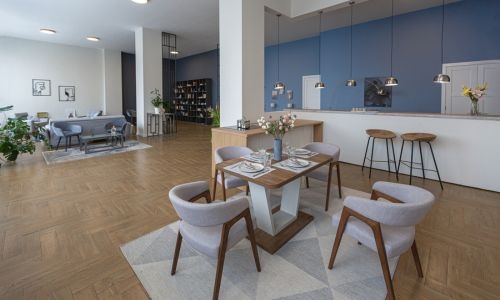 The rise of open-plan living
The rise of open-plan living
Open-plan spaces have been a favourite for many years, and they’re still going strong in 2025. The appeal lies in their ability to create an airy, flowing environment that’s perfect for family living or entertaining guests. Whether you’re cooking, dining, or relaxing, an open-plan layout can make a home feel more expansive and connected. This trend is especially popular in urban areas where space can be limited, and the goal is to maximise every inch. For homes with larger footprints, open-plan living allows for a multifunctional space that can easily be adapted to suit various needs—from work-from-home setups to spacious family gatherings.
Cosy corners: The counter-trend
While open-plan living is here to stay, many homeowners are starting to embrace cosy corners and more intimate spaces. As people spend more time at home, there’s a desire for rooms that offer retreat and relaxation. This trend is all about creating quiet, personal sanctuaries where you can unwind, read, or enjoy a cup of tea away from the bustle of family life. Think small nooks with comfy chairs, soft lighting, and rich textures. In fact, cosy corners have become a popular feature in living rooms, bedrooms, and even hallways, offering a contrast to the vast, open spaces of modern homes.
Sustainability meets design
As sustainability continues to be a top priority for homeowners, 2025 sees a strong focus on eco-friendly interiors. Sustainable materials like bamboo, reclaimed wood, and cork are gaining traction, as are energy-efficient appliances and natural finishes. Not only does this trend help reduce the environmental impact, but it also creates warm, earthy interiors that bring the beauty of nature indoors. Adding plants to your home, whether it’s a small succulent on the windowsill or a lush indoor garden, continues to be a favourite way to promote health and well-being while enhancing the natural feel of your space.
Smart homes: Technology that blends in
2025 is shaping up to be the year when smart home technology becomes an even more integrated part of interior design. Homeowners are increasingly seeking out technology that’s both functional and stylish. From smart thermostats that adapt to your schedule to voice-activated lighting systems, the key is to ensure these technological features are seamlessly blended into the home. Think minimalist design, with smart features subtly integrated into furniture or fixtures, offering both convenience and style.
Colour palettes: Earth tones and bold contrasts
While neutral tones like whites, greys, and beige continue to dominate, 2025 brings a shift towards warmer, earthier colours—think terracotta, deep greens, and rich browns. These hues create an inviting atmosphere and evoke a sense of comfort and calm. At the same time, bold contrasts are making their way into more modern homes, with dramatic combinations like navy and gold, black and white, or dark green paired with blush pinks. Mixing soft tones with bold accents allows for both serenity and excitement within a room.
Flexible spaces: A room for everything
As the hybrid work model becomes more entrenched, homes are being designed to cater to both work and leisure. Flexible spaces are key this year—rooms that can be easily adapted to suit various functions. Home offices are now more stylish, with ergonomic furniture, ample storage, and high-tech features. However, rather than one dedicated office space, many are opting for versatile rooms that can serve as a home gym, media room, or creative studio, depending on the family’s needs at any given moment.
Get in touch for expert tips to refresh your home with the latest trends
